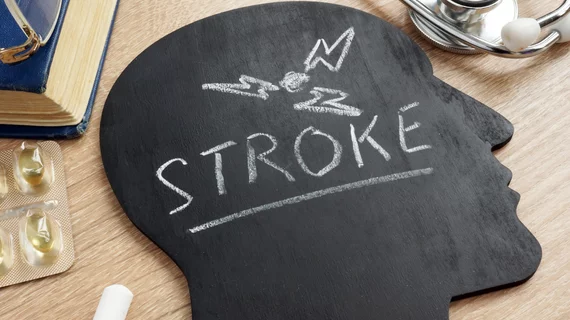TAVR patients face a higher risk of stroke for up to 2 years
Patients who undergo transcatheter aortic valve replacement (TAVR) face a heightened stroke risk for two years, according to new findings published in JACC: Cardiovascular Interventions.[1]
“Rates of TAVR-associated stroke have been well-studied in previous reports, but with the main focus on the short-term incidence, trends and clinical outcomes,” wrote first author Taishi Okuno, MD, a cardiologist with the University of Bern in Switzerland, and colleagues. “However, expansion of TAVR indications to low/intermediate-risk and younger patients, the parallel increase in the life expectancy of those undergoing the procedure, the availability of relevant data sources, and the increased recognition of late clinical and subclinical bioprosthetic leaflet thrombosis have all prompted a growing interest in the longer-term risk of stroke after TAVR and its prediction.”
Okuno et al. explored data from the SwissTAVI Registry, focusing on nearly 12,000 patients who underwent TAVR in Switzerland from 2011 to 2021. The average follow-up period for patients who were still alive was nearly 33 months. The mean patient age was 81.8 years old, 48% of patients were women and the mean Society of Thoracic Surgeons Predicted Risk of Mortality score was 4.6.
Femoral access was used for more than 92% of TAVR procedures. At discharge, the mean transprosthetic gradient was 8.3 mmHg. Moderate or severe aortic regurgitation was seen in 3.2% of patients. While 52.8% of patients were prescribed dual antiplatelet therapy at discharge, another 10.1% were prescribed single antiplatelet therapy.
The 30-day stroke rate among these patients was 3%, and 69% of those incidents occurred within 48 hours. The 30-day rate of cerebrovascular accidents (CVAs), a composite outcome including both strokes and transient ischemic attacks, was 3.3%. After one year, excluding those 30-day events, the stroke and CVA rates were 1.4% and 1.7%, respectively. In the second year after TAVR, the stroke rate was 1.2%; it was then less than 1% in the third, fourth and fifth year after TAVR.
Older patients and patients with moderate/severe paravalvular regurgitation at discharge faced an increased stroke risk in the first 30 days after TAVR. Dyslipidemia, a history of atrial fibrillation (AFib) and a history of a prior CVA were all linked to a higher long-term risk of stroke after TAVR.
In addition, the study’s authors compared the stroke rate among TAVR patients with a matched population of non-TAVR patients. This comparison confirmed that TAVR patients faced a “significantly higher” risk of stroke for the first two years following TAVR, but then the risk was comparable after that second year.
Potential explanations for the increased stroke risk up to two years
Okuno and colleagues wrote that “it would seem reasonable to assume” that a higher calcium burden explains why older patients and those with moderate or severe prosthesis regurgitation face an above-average stroke risk for those first two years. Also, the group highlighted a potential connection between new-onset AFib and stroke after TAVR.
“Silent new-onset AFib was found in nearly one-fifth of patients within the months following TAVR,” they wrote. “Although not reported in the literature, it is possible that silent AFib is also prevalent beyond the first few months, but it is unknown whether the prevalence of silent AFib at this stage is higher than that seen in the general population and, therefore, could account for the increased risk of stroke up to two years post-TAVR.”
The group concluded by highlighting the success of their study—believed to be the largest to date to examine this specific topic—but did say additional research is still needed “for a better understanding of the mechanism of late stroke after TAVR and to reduce the overall risk.”
Click here to read the full study.

